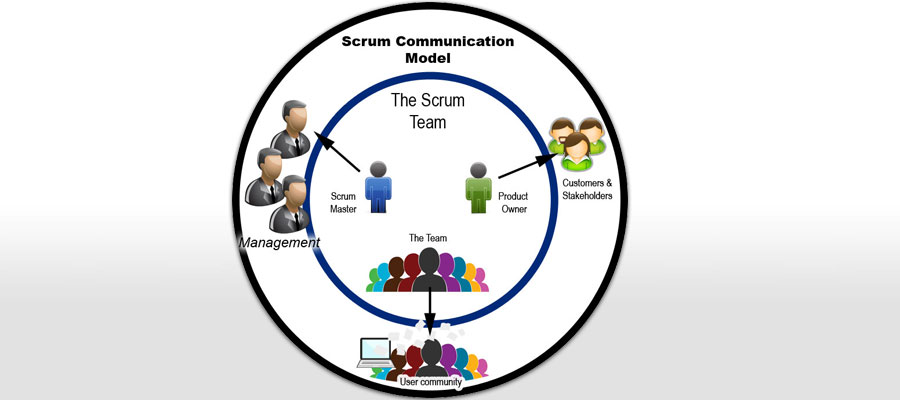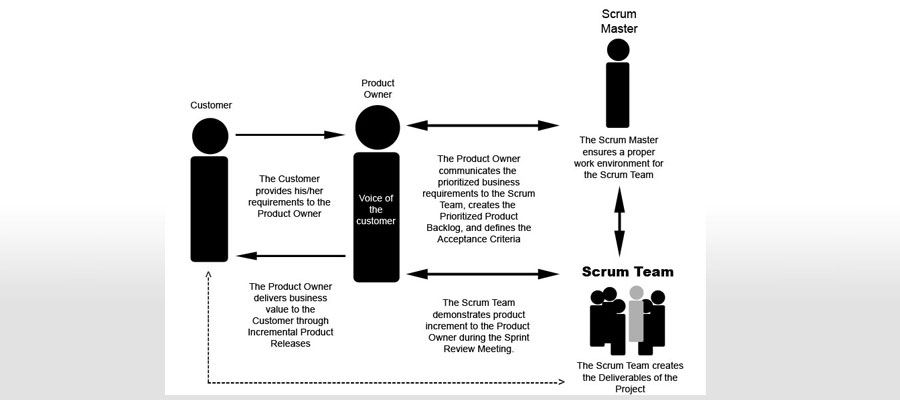04 FORM THE TEAM
Formation of the Scrum Team is a very important Task. The Scrum Team is at the heart of the process since these are the people who will realize the Product Owner's vision.
This vision is nothing except a list of features that the Product Owner wants, with no unifying principle or clear goal. This does nothing to guide the Team (or inspire the Team). It also rarely passes the elevator test and usually is difficult to remember. What it adds up to is that it does nothing to align the Team or help them make decisions, and as a result, the "secret sauce" in Scrum (self-organization) never emerges or emerges misdirected.
With "self-organization" comes responsibility and commitment. Therefore, the Product Owner have to look at more than just technical skills when selecting his or her Team. Some of the skills that normally are also needed are:
- Self-organization skills
- Communication and collaboration skills.
4.1.1 Self-organization skills
Self-organization is the ability to work in an ordered and methodical manner whilst being efficient and productive. Good self-organizational skills help us to cope with the world around us and are essential if we want to achieve personal goals as well as perform well in our job. These skills help keep us focused on doing the right Tasks, help us set our priorities and give us the confidence that we are following our chosen pathway to our desired destination.
Good self-organization requires the ability to prioritize, plan, manage time and work to deadlines. Self-organization is required for managing our time, resources, relationships, information, our environment, pressure and stress, and our behavior.
Limited self-organization skills may cause difficulties such as:
- Planning: setting achievable and realistic goals
- Implementing a systematic and organized strategy to achieve these objectives
- Identifying priorities
- Organizing one’s workload to maximize results
- Taking personal responsibility to achieve/exceed standards and expectations
- Taking responsibility to enhance one’s professional development by addressing and overcoming any weaknesses and fully utilize one’s strengths.
4.1.2 Communication and collaboration skills
Scrum attempts to simplify the often-confusing web of relationships through defining a clear set of roles and responsibilities.

Figure: Scrum Communication Model. The Scrum Team, Product Owner, The Team, Scrum Master; Customers and Stakeholders, User Community, Management
Within the inner circle we find the Scrum Team. This includes the Product Owner, Scrum Master and the Team. Within this boundary, there should be no barriers to communication. This Team is collectively held accountable for the success of the product, and there should be an open dialogue between all its members.
The outward focus of the Scrum Team’s communication is also illustrated above. The Product Owner’s focus of communication should be with Customers (who pay the bill) and other Stakeholders who may have an interest in the product. Ensuring that their voices are heeded in the development of the product is vital to ensure its successful outcome.
Through the interactions within this group, we can better understand what to build, but even more importantly, when to stop building functionality. The value of code not written is difficult to measure but undeniable; we have no need to build, maintain, debug, test or release this code.
The Team should as far as possible communicate directly with the user community. Sometimes this may be the same as the Customer (if you are dealing with a direct Customer-facing product). However, where this is not the case (as in many enterprise scale applications) having the Product Owner as a proxy or conduit for information from users is not advised. Face-to-face interaction (or at least direct communication) between the user community and the Team reduces the likelihood of miscommunication.
It is often the case that the Scrum Master might interpret his or her mandate to "protect the Team" over-zealously, and attempt to limit or eliminate interaction between the Team and users. However, this information is essential to the Team. The Scrum Master should protect the Team from interruptions, not information.

Figure: Organization in Scrum.
Customer—The Customer provides his/her requirements to the Product Owner.
Product Owner—"The Voice of the Customer": The Product Owner delivers business value to the Customer through Incremental Product Releases. The Product Owner communicates the prioritized business requirements to the Scrum Team, creates the Prioritized Product Backlog, and defines the Acceptance Criteria.
Scrum Master—The Scrum Master ensures a proper work environment for the Scrum Team.
Scrum Team—The Scrum Team demonstrates product increment to the Product Owner during the Spring Review Meeting. The Scrum Team creates the Deliverables of the Project.
4.2 Working with HR on formation of the Scrum Team
Just as in other projects, we normally have to go through the HR department to obtain resources to form the Team, and in some cases, the Scrum Team is also part of a program or a project, which is a layer on top that controls the budget.
If you are a Product Owner you will have to go through the normal administrative processes in the company to assemble your Team. This involves some or all of the below Tasks or some other process:
- People Requirements
- People Availability and Commitment
- Organizational Resource Matrix
- Skills Requirements Matrix
4.2.1 People Requirements
Identifying People Requirements is one of the initial steps in selecting the Scrum Master and the Stakeholder(s). It is important to document the roles and responsibilities of all those who will be involved in completing the Tasks in the project. This includes all individuals involved in the project in any capacity, regardless of whether their role is core or non-core.
Usually, the Product Owner or the Scrum Master work with the Human Resource Department of the company to determine and finalize the People Requirements for a project.
4.2.2 People Availability and Commitment
Prior to selecting the Scrum Master and Stakeholder(s), their availability must be confirmed. Only Team members who will be available and can fully commit to the project should be selected. People Availability and Commitment are commonly depicted in the form of calendars showing when human resources will be available to work throughout the duration of the project.
To be effective, Scrum Teams should ideally have six to ten members; and replacing persons or changing Team members is not advisable in Scrum Core Teams. Therefore, it is important to have persons in the Scrum Core Team who are available and fully committed to the project.
4.2.3 Organizational Resource Matrix
The Organizational Resource Matrix is a hierarchical depiction that combines a functional organizational structure and a project organizational structure. Matrix organizations bring together Team members for a project from different functional departments such as information technology, finance, marketing, sales, manufacturing, and other departments, and create cross-functional Teams.
Team members in a matrix organization fulfill two objectives—functional and project. Team members are directed by Product Owner(s) with respect to project related activities, while the functional managers perform managerial activities related to their departments such as performance appraisals and approving leaves.
4.2.4 Skills Requirements Matrix
The Skills Requirement Matrix, also known as a competency framework, is used to assess skill gaps and training requirements for Team members. A skills matrix maps the skills, capabilities, and interest level of Team members in using those skills and capabilities on a project. Using this matrix, the organization can assess any skill gaps in Team members and identify the employees who will need further training in a particular area or competency.
